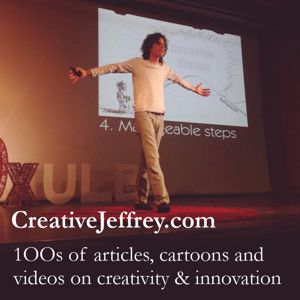Report 103
Your newsletter on applied creativity, imagination, ideas and innovation in business.
Tuesday, 22 November 2005
Issue 70
Hello and welcome to another issue of Report 103, your fortnightly newsletter on creativity, imagination, ideas and innovation in business.
As always, if you have news about creativity, imagination, ideas, or innovation please feel free to forward it to me for potential inclusion in Report103. Your comments and feedback are also always welcome.
Information on unsubscribing, archives, reprinting articles, etc can be found at the end of this newsletter.
KEEP INNOVATION SIMPLE, SWEETHEART
One of the underlying maxims of engineering is that of KISS, an acronym for “Keep It Simple, Stupid” or, as I prefer: “Keep It Simple Sweetheart”. And if you have ever watched a project evolve from concept to design to implementation, you will understand the importance of Kiss. When new ideas are at the drawing board, they are often simple, elegant concepts. But, as more people become involved, they all want to add features to the concept. As a result, the design must become increasingly complex in order so support all the proposed features.
However, many of those proposed features will prove useless. They will add complexity to the design of the project, they will make the finished product more expensive to purchase and maintain and they will offer no real benefits to the end user.
For example, let us imagine your team wants to make a chocolate cake. You begin to compile the recipe with ingredients like: flour, sugar, eggs, baker's chocolate, etc, when a team member says: “let's add walnuts. Chocolate cake with walnuts is yummy!”
And another team member suggests: “why don't we give it a whipped cream centre? I had a chocolate cake last week with a whipped cream centre and it was probably the best chocolate cake I've ever had.”
Meanwhile others suggest peanut-butter frosting, adding coconut flakes, layers of strawberry jam, shredded carrots on the top, making the cake in the shape of a turkey (to mark the US Thanksgiving holiday which is coming up), roasting the cake over an open fire, and so on.
Before you know it, the simple chocolate cake you began making is turning into a culinary disaster which will require a supermarket full of ingredients, take all day to make and will almost certainly taste terrible.
One way or another, the group needs to keep their cake simple and that will mean reducing the number of suggested ingredients and devising a simple, but tasty chocolate cake – probably focusing on quality ingredients and careful preparation rather than an excess of ingredients and convoluted preparation.
This is a lesson we should bear in mind when innovating. When looking at how to improve products or services we are almost inevitably looking for ways to make those products more complex. I have been using word processors for more than 20 years, including around a dozen years of Microsoft Word. In all that time, I have never seen a company roll out a simpler word processor – even though the number of new features introduced over the past ten years have been minuscule, offering no real added value, particularly in view of their added complexity. Indeed, my heart goes out to people – such as my neighbour - only now learning how to use MS Word. The number of absolutely useless features they face will only reinforce their beliefs that computers are overly complex.
In fact, when next brainstorming new product and service features, don't ask “what new features can we add to product X?” or “What new services can we offer to our customers?” Rather, ask “How can we make our product simpler to use?” or “How can we make our range of services simpler for our clients to understand.”
And it goes without saying that you should always be asking “how can we make our operations simpler?”, “how can we make our supply chain simpler?”
Indeed, simpler products and services not only benefit your clients, who often find simpler goods easier to use effectively, but also benefit you. If you can simplify product X so it requires fewer parts, you reduce your manufacturing costs. If your customers can understand your products better, you reduce your documentation and customer service costs.
In short, don't always innovate to make things more complex, innovate to simplify. And remember KISS.
FIRE UP THE CORPORATE IMAGINATION
Here's a suggestion: bring together a diverse team of your organisation's top thinkers, stretch their minds and have them spend a day brainstorming for ideas you have no intention of ever implementing. If you have an idea management tool like Jenni, you can even run an ideas campaign for ideas you are extremely unlikely ever to implement.
Sounds like a waste of time and money, doesn't it? In fact, firing up the corporate imagination and soliciting far out, outrageous and unlikely ideas is a beneficial exercise every company should perform from time to time.
The way to fire up the corporate imagination is with “what if” questions about the fundamental aspects of your products, your business and your customers.
Consider a fast food chain specialising in hamburgers. You might ask question such as:
- What if everyone in the country became vegetarian overnight?
- What if our competitors discovered a way to give away their hamburgers free – and still make a profit?
- What if we could no longer sell food in our outlets?
- What if we could have no employees in an outlet?
- What if the country REALLY got serious about weight loss and there was no market for fattening foods?
- What if we were to model our business more like a factory? A public library? An Internet company?
And a couple of not quite “what if” questions:
- If we wanted to completely destroy our credibility, what could we do?
- What is the worst thing our competitors could do to us tomorrow?
- And so on.
While, the ideas generated by these ideas campaigns or brainstorming sessions are unlikely to be implemented, they will likely suggest new opportunities for your business, provide new ways of thinking about your business and inspire ideas that are directly relevant to your business and can realistically be implemented. Moreover, firing up the corporate imagination and soliciting far out ideas is a powerful exercise that demonstrates your firm's commitment to creativity and pushes your creative thinkers to think even more creatively.
Lastly, encouraging people to push their thinking in such exercises encourages them to think more creatively on a regular basis and push their ideas further in more typical brainstorming sessions.
S go on, fire up your corporate imagination and see where it takes you...
JPB.COM INFO: PICTURING YOUR IDEAS
In many instances, an idea can better be expressed with an image than via text. A new logo, job flow, design improvements, sketches of new products and mind maps are all examples of ideas more readily expressed in a picture than in a block of text.
For this reason, Jenni idea management allows users to submit ideas with images. And those images are not just attachments. Rather they are images that appear with the idea for others to see and build upon. (Jenni is one of the only idea management tools that facilitates open collaboration across the enterprise).
For instance, if you want to run a company wide campaign for new product ideas, your employees can not only describe new product ideas. They can sketch, draw or photograph ideas and submit them to Jenni's collaborative environment.
Of course Jenni also lets users attach multiple documents and web links to ideas; making it easy to elaborate upon ideas with background papers, detailed charts and web based inspiration.
To learn more about Jenni – our simple, full service idea management solution - and how easy it would be to implement in your firm, contact me. Or check out http://www.creativejeffrey.com/jenni/ for more information.
JPB.COM INFO: GAINING KNOWLEDGE BY ASKING QUESTIONS
Our newest web service is Xandra Q&A, a simple knowledge sharing tool based on a simple principle: people learn by asking questions and evaluating answers.
Xandra functions rather like a web based discussion forum. If someone has a question, she simply publishes it on Xandra under the appropriate category. Her more experienced colleagues can read her question, answer it and even build upon each other's answers.
Xandra allows users to attach images, documents and web pages to their questions and provides sophisticated notification services that inform users when particular kinds of questions are asked – and when specific questions are answered.
Best of all, Xandra is available from just US$99 per month for up to 500 users - including full support. And you can even try out Xandra free of charge for the first month. If it doesn't work for you, we destroy your data and you owe us nothing.
Check out http://www.creativejeffrey.com/xandra/ for details or contact me.
REVIEW OF THE MAIN PRINCIPLES OF THE CREATIVE PROCESS
Dr. Stephen Sweid has kindly contributed an article on the fundamental processes involved in creative thinking, including analysis, analogy, synthesis, and transition to initial causes or objectives, using clear illustrations and examples to help grasp the mechanism involved, and explain the creative function of such processes.
The article, however, is reliant on a number of illustrations, hence I have not reproduced it here in Report 103. However, you can download a PDF (about 250kb) at http://www.creativejeffrey.com/creative/Sweid200511.pdf.
Happy thinking!
Jeffrey Baumgartner
---------------------------------------------------
Report 103 is a complimentary weekly electronic newsletter from Bwiti bvba of Belgium (a jpb.com company: http://www.creativejeffrey.com). Archives and subscription information can be found at http://www.creativejeffrey.com/report103/
Report 103 is edited by Jeffrey Baumgartner (jeffreyb@jpb.com) and is published on the first and third Tuesday of every month.
You may forward this copy of Report 103 to anyone, provided you
forward it in its entirety and do not edit it in any way. If you wish to reprint
only a part of Report 103, please contact Jeffrey Baumgartner.
Contributions and press releases are welcome. Please contact Jeffrey in the first instance.




